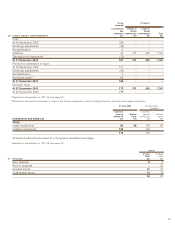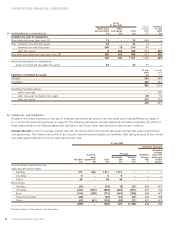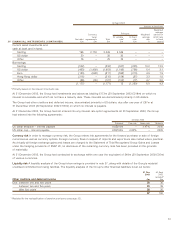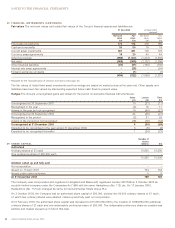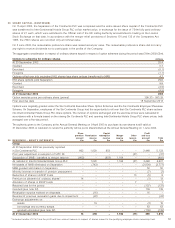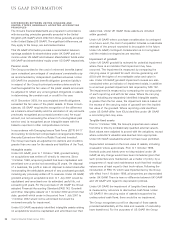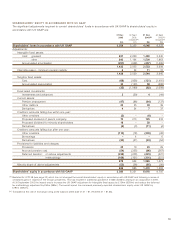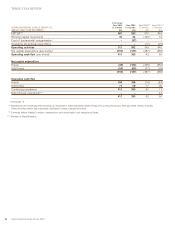Holiday Inn 2003 Annual Report Download - page 59
Download and view the complete annual report
Please find page 59 of the 2003 Holiday Inn annual report below. You can navigate through the pages in the report by either clicking on the pages listed below, or by using the keyword search tool below to find specific information within the annual report.57
Fixed asset investments
Fixed asset investments are stated at cost less any provision
for diminution in value. Under US GAAP, these investments are
recorded at market value and unrealised gains and losses are
reported in other comprehensive income except for other than
temporary which are recognised in the profit and loss account.
Derivative instruments and hedging
The Group enters into derivative instruments to limit its exposure
to interest rate and foreign exchange risk. Under UK GAAP,
these instruments are measured at cost and accounted for
as hedges, whereby gains and losses are deferred until the
underlying transaction occurs. Under US GAAP, all derivative
instruments (including those embedded in other contracts) are
recognised on the balance sheet at their fair values. Changes
in fair value are recognised in net income unless specific hedge
criteria are met. If a derivative qualifies for hedge accounting as
defined under US GAAP, changes in fair value are recognised
periodically in net income or in shareholders’ equity as a
component of other comprehensive income depending on
whether the derivative qualifies as a fair value or cash flow
hedge. Substantially all derivatives held by the Group during
the year did not qualify for hedge accounting under US GAAP.
Guarantees
The Group gives guarantees in connection with obtaining long-
term management contracts. Under UK GAAP, a contingent
liability under such guarantees is not recognised unless it is
probable that it will result in a future loss to the Group. For
the purposes of US GAAP, under FASB interpretation (FIN) 45
‘Guarantors Accounting and Disclosure Requirements for
Guarantees, Including Direct Guarantees of Indebtedness of
Others in the Year’, at the inception of guarantees issued after
31 December 2002, the Group would record the fair value of
the guarantee as an asset and a liability, which are amortised
over the life of the contract.
Proposed dividends
Final ordinary dividends are provided for in the year in
respect of which they are proposed by the Board for approval
by the shareholders. Under US GAAP, dividends would not
be provided for until the year in which they are declared.
Exceptional items
Certain exceptional items are shown on the face of the profit
and loss account after operating profit. Under US GAAP these
items would be classified as operating profit or expenses.
Discontinued operations
For the purposes of the reconciliation on page 58 the
discontinued operations are the same for both UK and US GAAP.
DIFFERENCES BETWEEN UNITED KINGDOM AND
UNITED STATES GENERALLY ACCEPTED ACCOUNTING
PRINCIPLES (CONTINUED)
would account for sales of real estate in accordance with
FAS 66 ‘Accounting for Sales of Real Estate’. Gains on sales
of real estate are deferred if there is a continuing involvement
with the property. Consequently the Group has reduced gains
on sales where this criteria exists.
Staff costs
The Group charges against earnings the cost of shares
acquired to settle awards under certain incentive schemes.
The charge is based on an apportionment of the cost of
shares over the period of the scheme. Prior to Separation the
Group accounted for those plans under the recognition and
measurement provisions of Accounting Principles Board (APB)
Opinion 25 ‘Accounting for Stock Issue to Employees’ and
related interpretations. Under APB 25 these awards would be
accounted for as variable plans and the charge would be based
on the intrinsic value of the shares using the share price at the
balance sheet date. Effective from the date of Separation, the
Group adopted the preferable fair value recognition provisions
of FAS 123 ‘Accounting for Stock-Based Compensation’.
The Group selected the modified prospective method of
adoption described in FAS 148 ‘Accounting for Stock-Based
Compensation – Transition and Disclosure’. Compensation cost
recognised since Separation is the same as that which would
have been recognised had the fair value method of FAS 123
been applied from its original effective date. In accordance
with the modified prospective method of adoption, results
for years prior to 2002 have not been restated.
Severance and restructuring costs
Under UK GAAP, severance costs are provided for in the
financial statements if it is determined that a constructive or
legal obligation has arisen from a restructuring programme
where it is probable that it will result in the outflow of economic
benefits and the costs involved can be estimated with
reasonable accuracy. Under US GAAP, severance costs are
recognised over the remaining service period to termination.
Accordingly, timing differences between UK and US GAAP
arise on the recognition of such costs.
Deferred taxation
The Group provides for deferred taxation in respect of timing
differences, subject to certain exceptions, between the
recognition of gains and losses in the financial statements
and for tax purposes. Timing differences recognised, include
accelerated capital allowances, unrelieved tax losses and
short-term timing differences. Under US GAAP, deferred
taxation would be computed on all differences between the
tax bases and book values of assets and liabilities which
will result in taxable or tax deductible amounts arising in
future years. Deferred taxation assets under UK GAAP and
US GAAP are recognised only to the extent that it is more
likely than not that they will be realised.


